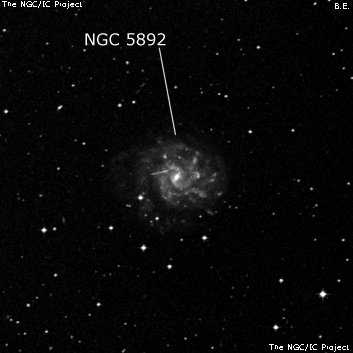
Ormond Stone discovered NGC 5892 = LM 1-227 in 1886 with the 26" refractor at Leander McCormick Observatory and recorded "mag 16.0, 2.5' gbM." There is nothing near his rough position (nearest min of RA). The RNGC identified MCG -02-39-007 = PGC 54365 as NGC 5892. This galaxy is nearly 3 minutes of RA west (not an uncommon error) as well as 30' south of Stone's position, but his description (especially size) does match this galaxy. Not surprisingly, due to the poor NGC positional match, Fath (see below), Shapley-Ames, Helwan observatory, MCG and RC2 failed to label this label this galaxy as NGC 5892. The Helwan observatory 1935 bulletin stated NGC 5892 was "not shown with 80 min exposure."
Edward Fath catalogued it as #703 in his 1914 paper "A study of nebulae", which included 864 new "nebulae" discovered on plates taken with the 60-inch at Mt. Wilson. Fath gave the dimensions as 2'16" x 2'16" and noted it was a spiral. The designation Fath 703 was used in the 1932 "Shapley-Ames Catalogue" of 1249 objects brighter than 13th photographic magnitude as well as in Sandage and Tammann's 1981 revised version. Due to the 30' discrepancy in declination and lack of a sketch, the identification of Fath 703 with NGC 5892 is uncertain but adopted in NED, HyperLEDA and SIMBAD.
400/500mm - 17.5" (7/9/94): very faint but fairly large, round, 2.5' diameter. Very low but uneven surface brightness (weak irregular concentration) with no distinct borders. Located just northwest of a group of five mag 13.5-14.5 stars forming a parallelogram asterism (the southern base consists of three collinear stars); the closest mag 13.5 star is just off the ESE edge 1.3' from center.
Notes by Steve Gottlieb